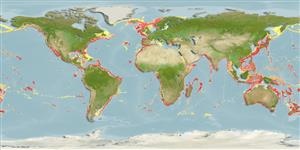>
Beryciformes (Sawbellies) >
Berycidae (Alfonsinos)
Etymology: Beryx: Greek, beryx or berys = a name of a fish. Cuvier & Valenciennes (1829:221) precise that the name was used by Gesner from Varinus, but with no indication whatsoever helping identifying any species. After D'Arcy Wentworth Thompson (A glossary of Greek fishes, 1947), the name actually seems to come originally from Hesychius, but perhaps the name was not originally a fish name. Thompson compares it to meryx (ruminant), applied on skaros (Scarus), so it may have been applied on a parrot fish referring to its browsing/grazing behavior described by Aristoteles and followers.
More on author: Cuvier.
Environment: milieu / climate zone / depth range / distribution range
البيئة
بحري قاعية المعيشة; نطاق العمق 110 - 1300 m (Ref. 126224), usually 200 - 800 m (Ref. 126224). Deep-water; 70°N - 48°S, 180°W - 180°E
Worldwide in temperate and tropical latitudes, except the eastern Pacific. Eastern Atlantic: Greenland, Iceland, and Norway to Western Sahara and South Africa, including western Mediterranean. Western Atlantic: south to Brazil. Also found in Argentine (Ref. 2806). Indo-Pacific: East Africa (including the Madascar Ridge and Saya de Malha Bank, Ref. 33390) to Japan, Australia, and New Zealand (Ref. 5755). The limited number of records in the western Pacific is doubtless the result of limited fishing effort below 200 m (Ref. 9833).
Length at first maturity / الحجم / وزن / العمر
Maturity: Lm 27.6 range ? - ? cm
Max length : 100.0 cm TL ذكر/ مختلط الجنس; (Ref. 26340); common length : 35.0 cm TL ذكر/ مختلط الجنس; (Ref. 9833); أعلا وزن تم نشرة: 4.0 kg (Ref. 126224); العمر: 69 سنين (Ref. 86253)
الأشواك الظهرية (المجموع) : 4; الأشعة الظهرية الناعمة (المجموع) : 18 - 20; شوكة شرجية: 4; أشعه شرجية لينه: 25 - 30. Body deep, compressed and has a large eye. Top of head, iris, back and all fins bright blood red. Orbital bones, cheeks and opercular bones shiny white. Breast shiny yellowish white. Body silvery with thin lengthwise lines (Ref. 37108).
Found in ca. 500 m on mud or sandy mud bottom (Ref. 11230). Occurs on the continental slope; adults demersal, young pelagic (Ref. 9563). Feeds on crustaceans, small fishes and cephalopods (Ref. 3321). A 35 cm SL specimen was found in the stomach of Latimeria (Ref. 58472). Young have heavy spines on the head (Ref. 35388).
Life cycle and mating behavior
النضج | التكاثر | وضع البيض | بيض | الخصوبة | Larvae
Maul, G.E., 1990. Berycidae. p. 626. In J.C. Quero, J.C. Hureau, C. Karrer, A. Post and L. Saldanha (eds.) Check-list of the fishes of the eastern tropical Atlantic (CLOFETA). JNICT, Lisbon; SEI, Paris; and UNESCO, Paris. Vol. 2. (Ref. 7413)
IUCN Red List Status (Ref. 130435: Version 2024-1)
استخدامات بشرية
مصائد: تجاري
أدوات
تقارير خاصة
Download XML
مصادر علي الأنترنت
Estimates based on models
Preferred temperature (Ref.
123201): 4.5 - 18.3, mean 11.2 °C (based on 1031 cells).
Phylogenetic diversity index (Ref.
82804): PD
50 = 0.6260 [Uniqueness, from 0.5 = low to 2.0 = high].
Bayesian length-weight: a=0.01445 (0.00900 - 0.02322), b=3.05 (2.91 - 3.19), in cm total length, based on LWR estimates for this species & (Sub)family-body (Ref.
93245).
مستوى غذائي (Ref.
69278): 4.1 ±0.76 se; based on food items.
المرونه (Ref.
120179): منخفض, الحد الزمني الأدني لتضاعف عدد أفراد المجتمع 4.5-14 سنة (K = 0.11-0.16; tmax >11).
Fishing Vulnerability (Ref.
59153): High to very high vulnerability (69 of 100).
Climate Vulnerability (Ref.
125649): High vulnerability (62 of 100).
Nutrients (Ref.
124155): Calcium = 12.8 [4.1, 39.6] mg/100g; Iron = 0.379 [0.162, 0.819] mg/100g; Protein = 17.2 [16.2, 18.3] %; Omega3 = 0.382 [0.155, 0.983] g/100g; Selenium = 22.9 [10.2, 51.9] μg/100g; VitaminA = 14 [3, 66] μg/100g; Zinc = 0.314 [0.209, 0.501] mg/100g (wet weight);
